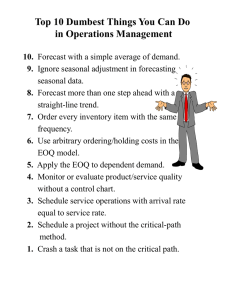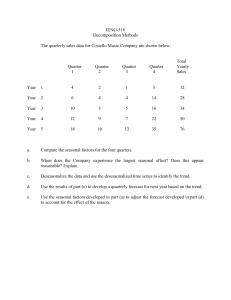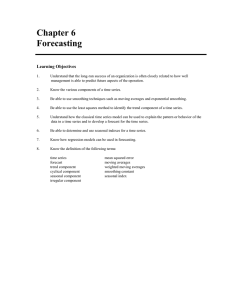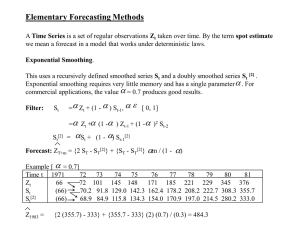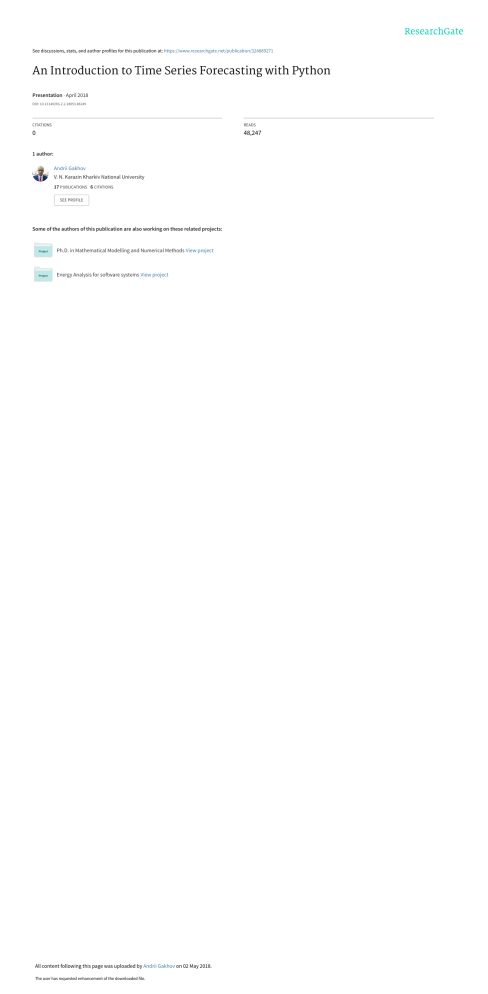
See discussions, stats, and author profiles for this publication at: https://www.researchgate.net/publication/324889271
An Introduction to Time Series Forecasting with Python
Presentation · April 2018
DOI: 10.13140/RG.2.2.18053.86249
CITATIONS
READS
0
48,247
1 author:
Andrii Gakhov
V. N. Karazin Kharkiv National University
17 PUBLICATIONS 6 CITATIONS
SEE PROFILE
Some of the authors of this publication are also working on these related projects:
Ph.D. in Mathematical Modelling and Numerical Methods View project
Energy Analysis for software systems View project
All content following this page was uploaded by Andrii Gakhov on 02 May 2018.
The user has requested enhancement of the downloaded file.
An Introduction to
Time Series Forecasting
with Python
Andrii Gakhov, ferret go GmbH
www.gakhov.com
PyCon UA, Kharkiv, April 28-29, 2018
What is a Time Series?
A sequential set of data points
measured over time.
time.
x(t), t = 0, 1, 2, 3, . . .
t
- a variable that represents the elapsed time.
Examples
hourly number of page views for a website
daily air temperature in a city
monthly average number of reported bugs
quarterly income for a company
annual population data in a country
A Time Series may contain information
about general tendency in data,
seasonal e ects, occasional events, and so on.
Time Series Decomposition
Trend
The general (long-term, non-periodic)
tendency of a time series
Often modeled using the logistic growth model, or can be extracted from data using Moving Average technique
Example
The WoldBank Dataset, London afternoon xing, Gold 99.5%, average of daily rates
Seasonal
The periodic uctuations
caused by regular in uences
Can be modeled using Fourier series
Example
European Climate Assessment & Dataset, Air temperature in Berlin
Cyclical
The medium-term uctuations caused
by cyclicaly occured non-periodic in uences
Example
London W., Yorke J.A., The monthly reported number of cases of measles, New York city
Irregular
Random variations caused
by unpredictable in uences
Example
valuta.today, Daily average EUR-UAH exchange rates in the cash market, Ukraine
Time Series
Decomposition Model
There are 2 main models that generally used
to model the e ects of these components
.
The choice of the decomposition model is called test for log-level speci cation
Additive model
Assumes that the four components are independent
Y (t ) = T (t ) + S(t ) + C (t ) + I (t )
When to choose the Additive model
The behaviors of the components are independent,
i.e. an increase in the trend-cycle will not cause an increase in the magnitude of seasonal
The di erence of the trend and the raw data
is roughly constant in similar periods of time
irrespectively of the tendency of the trend
The pattern of seasonal variation
is roughly stable over the year
i.e. the seasonal movements are the approximately same from year to year
https://ec.europa.eu/eurostat/sa-elearning/additive-decomposition-0
Multiplicative model
Assumes that the components are dependent
Y (t ) = T (t ) ⋅ S(t ) ⋅ C (t ) ⋅ I (t )
By taking logs it is possible to present the multiplicative model
in an additive form. This is called log-additive model.
When to choose the Multiplicative model
Components on the graph jump in magnitude over time
The seasonal and irregular uctuations
change in a speci c manner after the trend
i.e. the amplitude of the seasonality increase (decrease) with an increasing (decreasing) trend
Additive vs. Multiplicative
Additive:: Alcoholic Drinks, Beverages & Tobacco retail sales, UK; Multiplicative
Additive
Multiplicative:: International airline passengers
Demo
Meet the dataset
Total number of visits to the UK by overseas residents
Source: O ce for National Statistics
https://github.com/gakhov/pycon-ua-2018/blob/master/look-into-the-data.ipynb
The Roadmap
Data - Decomposition Model - Forecasting Model - Training - Prediction
How To Measure
The Forecast Performance
The Mean Forecast Error (MFE)
1
n
n ∑
(xt − ft )
t =1
A good forecast has the MFE close to zero
Provides the direction of the error
M F E = 0 doesn't guarantee that the forecast contains no errors
(positives can cancel negative errors)
Sensitive to observations scale and data transformations
Doesn't penalize extreme errors
The Mean Squared Error (MSE)
1
n
n ∑
(xt − ft )
2
t =1
from sklearn.metrics import mean_squared_error
A good forecast has the MSE close to zero
Shows the overall idea of the error
Emphasizes the fact that the total forecast error
is much a ected by large individual errors
Sensitive to observations scale and data transformations
Penalizes extreme errors
The Normalized Mean Squared Error (NMSE)
1
σ
2
n
n ∑
(xt − ft )
2
t =1
The smaller the NMSE, the better the forecast
It's balanced error measure
Very e ective in judging forecast accuracy of the model
The Coe cient of Determination (R )
2
2
R
= 1 −
∑ (xt − ft )
∑ (xt − x
x̄
¯)
2
2
from sklearn.metrics import r2_score
A good forecast has the R2 close to one
Estimates the variability of the forecast around its mean
2
R
≤ 1
Doesn't indicate whether the model is adequate
Theil's U
n‾‾‾‾‾‾‾‾‾‾
1‾‾‾‾
‾
2
∑
(xt − ft )
t =1
√n
U =
1‾‾‾‾‾‾
1‾‾‾‾‾‾
‾
‾
2
2
∑f
∑x
t √ n
t
√n
A good forecast has the U close to zero
A normalized measure of total forecast error
0 ≤ U ≤ 1
U = 0
means the perfect t
Models
There are many di erent approaches,
but here we focus on the top 3 families.
Stochastic Models
with Python
ARMA Model
Assumes that data are
a realization of a stationary process
Augmented Dickey-Fuller (ADF) unit root test,
Kwiatkowski-Phillips-Schmidt-Shin (KPSS) test
AR - autoregression process (long memory)
Have a relatively long memory, because the current observation
is correlated with all previous ones, although with decreasing coe cients
MA - moving average process (short memory)
Have a short-term memory, since it's just a function of a nite,
and generally small, number of its past observations.
ARMA is to combine these properties
and represent model in a simpli ed form
whose rst q coe cients can be any,
whereas the following ones decay according to simple rules.
ARMA(p, q)
p - the lag order (AR)
the number of lag observations to include
q - the order of moving average (MA)
the size of the moving average window
ARIMA
Autoregressive Integrated Moving Average
A generalization of an ARMA for
Integrated (Di erence Stationary) Time Series
Non-stationary time series whose di erences of some order are stationary.
Non-stationary time series are di erenced
until stationarity is achieved (Box–Jenkins method)
Doesn't support seasonal component modeling
ARI MA(p, d, q)
p - the lag order (AR)
the number of lag observations to include
d - the degree of di erencing (I)
the number of times that the raw observations were di erenced
q - the order of moving average (MA)
the size of the moving average window
The data has to be prepared by a degree of di erencing to make time series stationary,
i.e. by removing trend and seasonal structures that negatively a ect the regression model.
ARMA corresponds to d=0.
SARIMA
Seasonal Autoregressive Integrated Moving Average
A modi cation of ARIMA to support a seasonal time series.
ARI MA(p, d, q) × (P, D, Q)s
(p,d,q) are the non-seasonal parameters
(P, D, Q) the seasonal component of the time series.
is the seasonal periodicity
s
(4 for quarterly periods, 12 for yearly periods, etc.)
Check whether there is any evidence
of a trend or seasonal e ects
Stationarization by taking di erences
Seasonal component research
Python Tools
Statsmodels
A high-level module to work with statistical models,
conducting statistical tests and data exploration.
https://www.statsmodels.org/
from statsmodels.tsa.statespace import sarimax
model = sarimax.SARIMAX(
X_train,
trend='n',
order=(1,1,1),
seasonal_order=(1,1,0,12),
enforce_stationarity=True,
enforce_invertibility=True)
results = model.fit()
steps = X_train.shape[0]
forecast = results.get_forecast(steps=steps)
forecast_ci = forecast.conf_int()
yhat_test = forecast.predicted_mean.values
Demo
Build a Seasonal AutoRegressive Integrated Moving Average model
to predict the number of visits to the UK by overseas residents
https://github.com/gakhov/pycon-ua-2018/blob/master/stochastic-models.ipynb
Python Tools
Prophet
A tool for producing forecasts for time series data
that has multiple seasonality with linear or non-linear growth.
https://github.com/facebook/prophet
Prophet Forecasting Model
Based on ARIMA and utilizes a Bayesian-based curve tting method
X (t ) = T (t ) + S(t ) + H (t ) + εt
T (t )
- trend, S(t ) - seasonal e ects, H (t ) - holidays (potentially irregular), εt - unpredicted e ects.
The seasonality is modeled by the Fourier Series.
from fbprophet import Prophet
m = Prophet()
m.fit(df)
forecast = m.predict(df)
m.plot(forecast)
m.plot_components(forecast);
Demo
Build a Prophet Forecasting Model
to predict the number of visits to the UK by overseas residents
https://github.com/gakhov/pycon-ua-2018/blob/master/prophet.ipynb
Arti cial Neural Networks
with Python
ANN can be seen as a computational graph
nodes are computing units
directed edges transmit numeric information
Each computing unit (neuron) is capable of evaluating
a single primitive function (activation function) of its input.
At practive, units are organized in layers.
Popular ANNs types
Recurrent Neural Network
Similar to Feedforward networks, but allows a recurrent hidden state
with activation depended on the previous cycles.
cycles.
Long Short-Term Memory (LSTM) architecture
Unlike the traditional recurrent unit,
which overwrites its content each timestep,
the LSTM unit can decide whether to keep the existing memory
via introduced additional convolution steps (gates)
Read More: https://www.slideshare.net/gakhov/recurrent-neural-networks-part-1-theory
The main problem while working with ANNs
is the choice of the network's parameters,
such as the number of layers and number of neurons.
SANN
Seasonal Arti cial Neural Networks
only 1 hidden layer
number of input and output neurons
can be taken as number of observations in a season
number of hidden nodes
should be detemined experimentally (a few)
* as recommended by C. Hamzaçebi.
How to build a model
We want to teach SANN to learn next season value
from the previous season values
Using sliding-window technique transform time series to a number of s-dimensional vectors
Python Tools
Keras
A high-level neural networks API,
capable of running on top of TensorFlow, CNTK, or Theano.
https://keras.io/
from keras.layers import InputLayer, Dense, LSTM
from keras.models import Sequential
from keras.optimizers import SGD
model = Sequential()
model.add(InputLayer(input_shape=(1, seasons), name="input"))
model.add(
LSTM(4, name="hidden", activation='sigmoid',
use_bias = True, bias_initializer='ones')
)
model.add(
Dense(seasons, name="output", activation='linear',
use_bias = True, bias_initializer='ones')
)
model.compile(loss='mean_squared_error',
optimizer=SGD(lr=0.05, decay=1e-6, momentum=0.9),
metrics=["mae", "mse"])
history = model.fit(X_train, y_train, epochs=100, batch_size=1,
validation_data=(X_val, y_val))
yhat_test = model.predict(X_test[::seasons])
Demo
Build a Seasonal Arti cial Neural Network with LSTM layer
to predict the number of visits to the UK by overseas residents
https://github.com/gakhov/pycon-ua-2018/blob/master/arti cial-neural-networks.ipynb
Support Vector Machines
with Python
A technique that maps data
into a high-dimensional feature space
where it can be linearly separable in the best way.
Support vectors are "critical" observations that fully specify the decision function
Support Vector Machine Regression
Performs a linear regression
in the high-dimension feature space
with a special ε-intensive loss function.
Main SVM meta-parameters
ε
-tube for no penalty
Controls the width of the ε-insensitive zone, used to t the training data.
Bigger ε -values result in more ' at' estimates (fewer support vectors).
Penalty parameter C
Controls the amount up to which deviations larger that ε is tolerated.
Prevents over tting and in a trade-o with the model complexity.
Kernel function type
Induces the high-dimentinal feature space.
Most popular are linear, polynomial and Gaussian Radial Basis Function (RBF) kernels.
How to build a model
We want to train SVM Regressor to learn value at time t
from the previous season values
Using sliding-window technique transform time series to a number of s-dimensional vectors
Python Tools
Scikit-learn
A simple and e cient tool for machine learning,
data mining and data analysis.
http://scikit-learn.org/
from sklearn import svm
from sklearn.model_selection import GridSearchCV
from sklearn.model_selection import ShuffleSplit
C_range = np.logspace(-2, 10, 5)
gamma_range = np.logspace(-9, 3, 5)
param_grid = {
"gamma": gamma_range,
"C": C_range,
"epsilon": 0.1
}
cv = ShuffleSplit(n_splits=3, test_size=0.25, random_state=73)
grid = GridSearchCV(
svm.SVR(kernel="rbf", max_iter=100),
param_grid=param_grid,
cv=cv)
grid.fit(X_train, y_train)
model = grid.best_estimator_
yhat_test = model.predict(X_test)
Demo
Build a Seasonal Support Vector Regressor
to predict the number of visits to the UK by overseas residents
https://github.com/gakhov/pycon-ua-2018/blob/master/support-vector-machines.ipynb
Final Notes
Always visualize the data
Think which decomposition model
better describes you data
Select a proper forecasting model
Divide the raw data into 2 parts (training / test sets).
Small part of the training set reserve for validation
Final Notes
The observations only from the training set
shell be used for the model construction
Use the test set to verify how accurate
the constructed model performs
Many models expect normalized, scaled data as input
(check Box-Cox Transformation, log-scaling, etc.)
View publication stats
Thank you
These slides can be found at
https://github.com/gakhov/pycon-ua-2018
Andrii Gakhov, ferret go GmbH
www.gakhov.com
PyCon UA, Kharkiv, April 28-29, 2018

